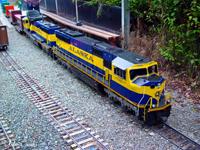
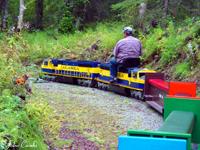
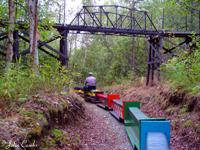
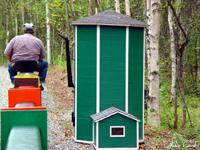
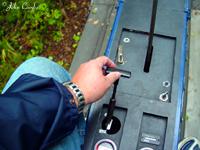

Sunday, August 28, 2005
My head is screaming as the alarm sounds at 6:40 am. Four and a half hours of sleep was just not enough. After a quick breakfast and shower, I am on the road again. By 9:00 am I am at the Live Steamers track in Wasilla. Jack Klingbeil is there to meet me and is eager to show off his beautiful 1.7 scale SD70MACs. And boy are they beautiful! The lead unit is fully powered and weighs 1150-pounds while the second unit is a 950-pound dummy. Construction of the first unit began around December 2001 and both were completed by June 2003. Jack tells me he has used his MACs to pull up to 45 people.
With Jack at the throttle, I leap aboard, ready for fun. And fun it is! We travel through heavily wooded sections [click here to view the 1.2MB video], over a very high wooden trestle [click here to view the 1.8MB video], and by various scale buildings. We stop at an Orthodox church model and Jack tells me the story behind the three-bar cross. Much to my amazement, Jack puts me on the lead SD70MAC and lets me play engineer for a while! The controls are very simple and it isn't long before I feel like a pro. We pull into the station all too soon and the excursion is over. Unfortunately, I have a 10:00 am appointment or I would stay all day long!
 |
 |
 |
| Jack's MACs | Jack on a MAC | Under a hand built trestle |
 |
 |
 |
| Matanuska water tower | My hand on the throttle | Crossing a bridge |
When it comes to getting lost, I am an expert. So it really doesn't come as a surprise to me that I have difficulty finding my way back to Jeff DeBroeck’s house. Although I arrive 20 minutes late, Jeff "cop car killer" DeBroeck doesn't seem to mind. After meeting me in the driveway, he takes me inside to look at his very precise and expertly constructed HO scale prototypical models. He and Pat Durand were competing to be the first one to build one of every type of Alaska Railroad locomotive. However, with Jeff working a frenzied summer MOW schedule, he eventually conceded the race.
Jeff then asks me if I'd like to go hiking along the Matanuska River in search of old railroad remnants. Of course I do, but since my boots self-destructed the day before, all I have is a pair of tennis shoes. Jeff assures me this will not be a problem. So we drive to the Matanuska River for a "land of the lost" walk through the past. For those of you who have read my past trip journals, you know I have a fascination with exploring decaying structures (see Buckner Building or the old Loop District) in pursuit of mystery and excitement.
The trail starts off easy enough, but soon presents some very large puddles. Teasingly I say to Jeff, "I thought you said I wouldn't need hiking boots?" He just smiles and walks on. Eventually the trail swings along side the river and becomes even wetter and muddier. "Boots?" I say again. At every deep puddle or large rock slide, I give the "boots" cry. Finally, Jeff has heard enough. He pats the holstered bear protection he is carrying and reminds me if we do encounter a bear, he can just shoot me instead and then walk away. The "boots" cry is no longer heard.
Soon we are finding old train cars that were dumped into the river in the 1950s. The railroad did this for use as rip-rap, thus keeping the river bank and railroad bed from eroding away. We locate old gondolas, flatcars and boxcars. Jeff jumps down to a sand bar for a closer look. When I jump down to the river bed, the impact causes my lower back to cry out in pain and my mouth to scream profuse profanity. Even so, I am having a good time.
We eventually locate the cab to an old steam locomotive with a number 10 on the side. Although it is a 500 class Alaska Railroad locomotive, the number 10 is from its former days with the U.S. Army. [Note from Dick Morris - It is apparently USATC 7881, Claiborne and Polk 10, ARR 503, ARR 403. Caliborne and Polk was the military training railroad at Camp Claiborne where 503, as well as 561 and 562 (I think) operated before coming to the ARR.] I really want a souvenir from our hike so Jeff breaks loose a set of switches from the cab. Further down we find a passenger car with four large holes in its side where a ditcher was used to push it over the edge. In Pat Durand's story, "The Railroad Bone Yard," he later determined it to be The Yukon.
During our hunt, we find a gravel area with a large number of salmon spawning. This is the first time I have seen anything like this and I find it fascinating to watch. Several dead salmon are also lying up on the sand. Jeff explains most salmon spawn only once during their lifetime and die within a week of spawning. He also emphasizes we need to keep a sharp eye out for bear.
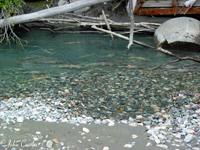 |
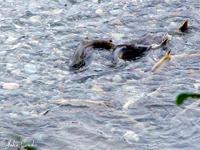 |
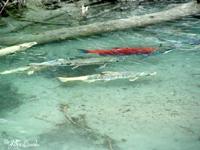 |
| Salmon spawning | Salmon half out of the water | Salmon spawning |
We return to Jeff’s house at 4:30 pm. My arms and back are killing me from carrying back ten pounds of locomotive switches and my tennis shoes are wet and slimy. However, his wife cooks up beer batter halibut, mashed potatoes and green beans and soon I am good as new! We then look through Jeff’s railroad photos and he gives me some to take home and scan for my web site. Our visiting time comes to an end far too soon and I eventually depart, returning to Don’s by 9:50 pm. When I finally fall into bed at 11:00 pm, I am sore and exhausted, but extremely satisfied. As I am dozing off to sleep, I consider writing a book entitled; Kids Without Toy Trains are Basically Evil.